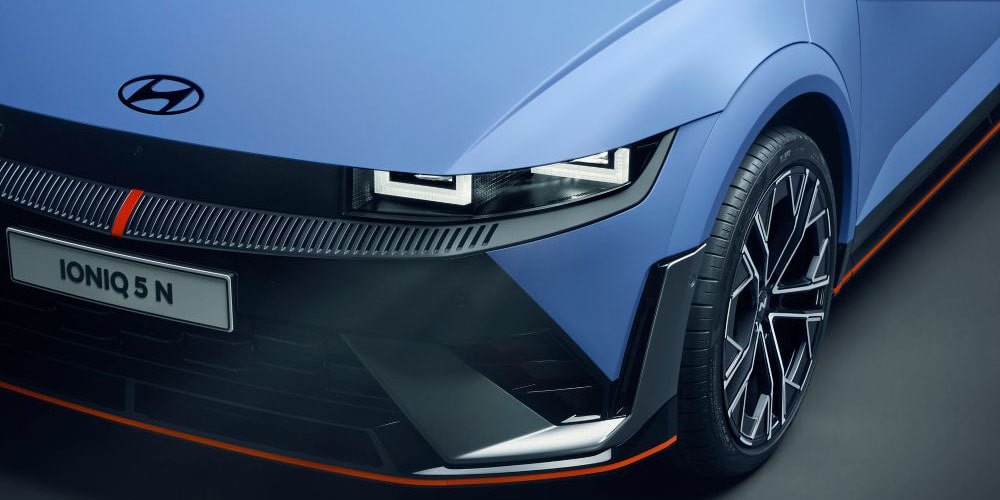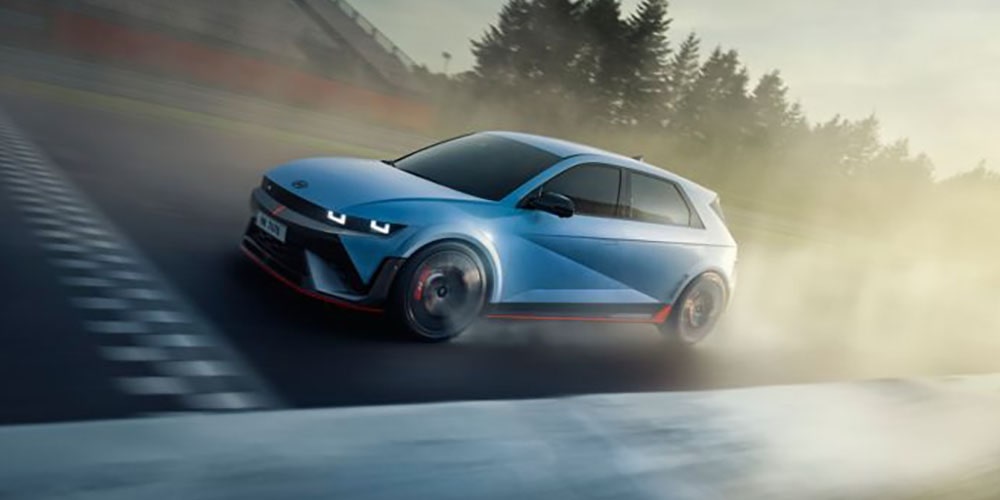Hyundai presents the Ioniq 5 N performance model
The basic concept of the Ioniq 5 N and the EV6 GT is the same: both E-GMP models rely on a two-motor all-wheel drive and an 800-volt battery. For the rear electric motor, both vehicles rely on a two-stage inverter with increased energy efficiency coming from the SiC semiconductors sourced from Onsemi for this.
While the EV6 GT comes to 430 kW of power, the Hyundai Ioniq 5 N offers 448 kW of system power, with ‘N Grin Boost’ activated, the maximum power rises to 478 kW. A new battery with a capacity of 84 kWh is installed for the energy supply. An optimised battery thermal management system is based on an enlarged cooling surface. Hyundai will only announce the range of the Ioniq 5 N with the market launch.






Hyundai does not mention the new battery in the announcement. It is therefore not known whether the difference to the previous 77.4 kWh battery is achieved by additional modules or a modified cell chemistry with higher energy density. There is also no information on charging performance and duration, but even the top model is unlikely to deviate from the known 18-minute charging time.
For this, Hyundai goes into detail about the further developed thermal management, which is based on an enlarged cooling surface and is supposed to “significantly” improve the engine and battery cooling. “The Ioniq 5 N is particularly resistant to heat-induced loss of power,” the South Korean company writes. This was not always the case. For the performance model, there is a special feature in thermal management: before driving, the driver can use battery preconditioning to bring the battery cells to the most energy-efficient state. He can choose between the ‘Drag’ mode for a short full-load drive and the “Track” mode, which optimises the lowest possible battery temperature for several laps.
In addition, the ‘N Race’ function is intended to give the driver “more direct control over the vehicle’s energy consumption”. There is a choice between ‘Endurance’ and ‘Sprint’ in the software. ‘Endurance’ maximises the range on the race track. According to Hyundai, this is achieved by limiting peak power, which results in a slower temperature rise. ‘Sprint’, on the other hand, focuses on performance and delivers maximised energy boosts.
Recuperation has also been newly developed: with Hyundai N’s system, deceleration of up to 0.6g is possible, which is “an industry-leading value”, according to the announcement. With ABS activated, the vehicle can still decelerate electrically with 0.2g. Despite the improved recuperation, the brakes have also been upgraded: the Ioniq 5 N has 400mm front discs with four-piston monobloc calipers and 360mm rear discs.
Compared to the standard model, the Ioniq 5 N is 20mm lower, 50mm wider and 80mm longer. Other changes to the body are related to rigidity, this has been increased with 42 additional weld points and 2.1 metres of additional bonded parts. The engine and battery mounts have been strengthened, while the front and rear subframes provide increased lateral rigidity. The steering column has also been reinforced.
Hyundai simulates gear jerk and combustion engine sound
There are also all sorts of other software features, from an ‘N Drift Optimizer’ that helps maintain the drift angle. Or ‘Track SoC’, which automatically calculates and displays the battery consumption per lap on a race track. ‘N Launch Control’ offers three different traction levels for the fastest possible launch. And then there are the rather controversial features ‘N e-shift’ and ‘N Active Sound+’. ‘N e-shift’ simulates “a gearshift by controlling motor torque output and simulates the jolt feeling between shifts”, while ‘N Active Sound+’, according to the company, “delivers not only a futuristic electric sound inside and out, but also combustion engine-like engine and exhaust sounds that make for an engaging experience behind the wheel”. “Together, they enhance the fun and joy of driving by simulating the jolt feel and sound of an ICE vehicle,” the statement said.
When the market launch will take place and at what prices is not yet revealed by Hyundai in its announcement. According to Motor1, the market launch of the Hyundai of the Ioniq 5 N in Europe is planned for the end of the first or the beginning of the second quarter of 2024.
Update 27 October 2023
Hyundai Motor UK has announced pricing and specifications for the Ioniq 5 N, as well as officially opening the order books. Prices for the performance EV start from £65,000.
Hyundai specifies that like the standard IONIQ 5, the N variant is built on the 800V Electric Global Modular Platform, offering ultra-fast charging compatibility and Hyundai’s Vehicle-to-Load technology.
The 84-kWh battery can be charged with up to 350 kW on a CCS charger, which can take up to 36 minutes to an 80 per cent charge. The maximum power from the drive stands at 478 kW and 740 Nm torque. The top speed is 161 miles per hour, and it can accelerate to 62 mph from a standstill in 3.4 seconds.
Update 21 March 2024
Hyundai has now also announced pricing for its Ioniq 5 N in the US. The electric SUV starts at 66,100 dollars, not including a 1,375 freight fee.
The carmaker specifies that the Ioniq 5 N “is offered in a single, fully equipped trim.” It comes with an all-wheel drive and two electric motors with 166 and 282 kW. Together, they provide an estimated 641 horsepower.
The Ioniq 5 N is fitted with an 84-kWh battery that can be charged with 238 kW at a 350 kW DC charger. Charging from ten to 80 per cent then takes 18 minutes. The top speed is limited to 162 mph. Hyundai does not give an EPA range in its recent press release.
hyundai.news, motor1.com, hyundai.news, hyundai.news (pricing & specifications, PDF), hyundai.news (technical data, PDF), hyundainews.com (US pricing)





0 Comments